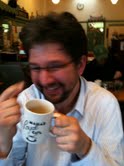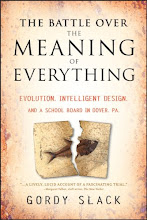 |
| Raphael's seizure |
If you’re reading this you have probably known an epileptologist or two. So you can begin to imagine how remarkable—daunting frankly--it is to have 4,000 of them in one hotel talking about epilepsy from sun up to sun down. That’s the situation here in Rome at the 29th International Epilepsy Congress, from where I will post from time to time over the next four days. I am calling it InterUberEpFest 2011 and it is nonstop talk about epilepsy, epilepsy, epilepsy, in every language and from just about every imaginable point of view.
It is fitting that this conference is unfolding in Rome. For one thing, the city was home to two of the most famous epileptics in history: Julius Caesar and Michelangelo, and though one has been dead two thousand years and the other nearly half a millennium, evidence of their extraordinarily creative lives and characters are all over this amazing city. For another, this years Congress celebrates the Jubilee of the International Bureau for Epilepsy, which was formed at a meeting here in Rome fifty years ago. In the decades since then, the IBE has worked hard around the world—though with a European focus--to turn social views of epilepsy on their head. The prevailing stigma and lack of support for epilepsy research so prevalent early in the 20th century, are hard to imagine now. We have come a long way, and it’s important not to lose sight of that. But we have a long way to go still.
The attitudinal distance we still need to cover was highlighted in this morning’s big session on Unexplained Death from Epilepsy, or SUDEP. Doctors, and particularly American doctors, have come under a lot of criticism for their reluctance to discuss the possibility of death from epilepsy with their patients or, in case of children with epilepsy, with their families. Susan Axelrod, founder of the Citizens United for Research in Epilepsy (CURE,) was the first speaker at this morning’s session, and she gave an impassioned plea for better patient-doctor communication about SUDEP. She described her own experience as a cancer patient; even in the traumatic moments of her original diagnosis, her doctor never pretended that her illness was not potentially lethal. Only because he shared the truth with her could they collaborate to fashion the best plan to keep her alive. Yet epilepsy patients are routinely deprived of that realistic evaluation.
Axelrod’s daughter, Lauren, had her first seizure at 7-months-old. In the traumatic early years of Lauren’s epilepsy, the Axelrods spent weeks in the hospital, ran through 20 different AEDs, and attended the hundreds of doctor’s appointments such prescription and re-prescription entails, but never once did a doctor tell them that Lauren’s life might be in danger. And yet it most certainly was…and still is.
Also in the session was renowned Baylor epileptologist and researcher Jeffrey Noebels, who has done seminal work locating SUDEP genes. He said that at least in some cases SUDEP could now more accurately be called SDEP, because identification of a genetic mutation that causes an iron-channel defect that links seizures and sudden cardiac malfunction, took the “unexplained” out of at least one kind of SUDEP. A signature EKG form now allows epileptologists to screen for that disorder, and Nobels recommends that EKGs be routinely conducted on patients with seizures.
I have to rush back to the conference. But I want to mention another excellent session today in which Harvard neuroscience professor Steven Schachter gave a riveting account of the artworks he has collected from patients with epilepsy over the decades. Art is often a nuanced but powerful way of communicating the suffering, isolation, and anxiety that often accompanies epilepsy, says Schacter, and while making art can have great therapeutic value, a doctor’s clinical attention to it can also have diagnostic value.
While Schacter’s talk emphasized the suffering of epilepsy patients, another talk in this session, by Australian doctoral student and artist Jim Chamblis, looked at research suggesting that, in his words, “epilepsy, which is most often perceived as disabling, in some circumstances can actually be enabling by enhancing creativity.” Now that’s turning stigma on its head!


No comments:
Post a Comment